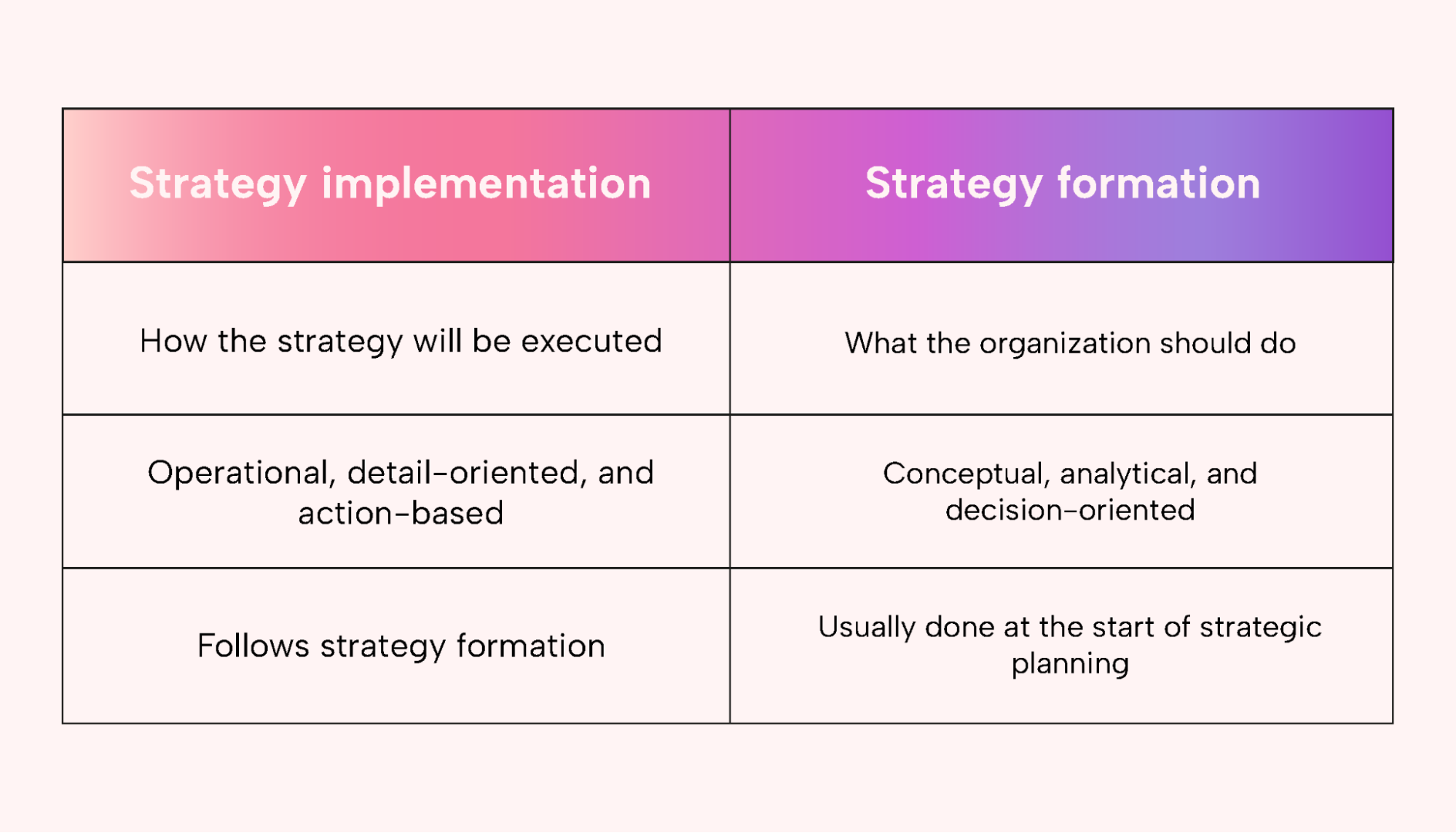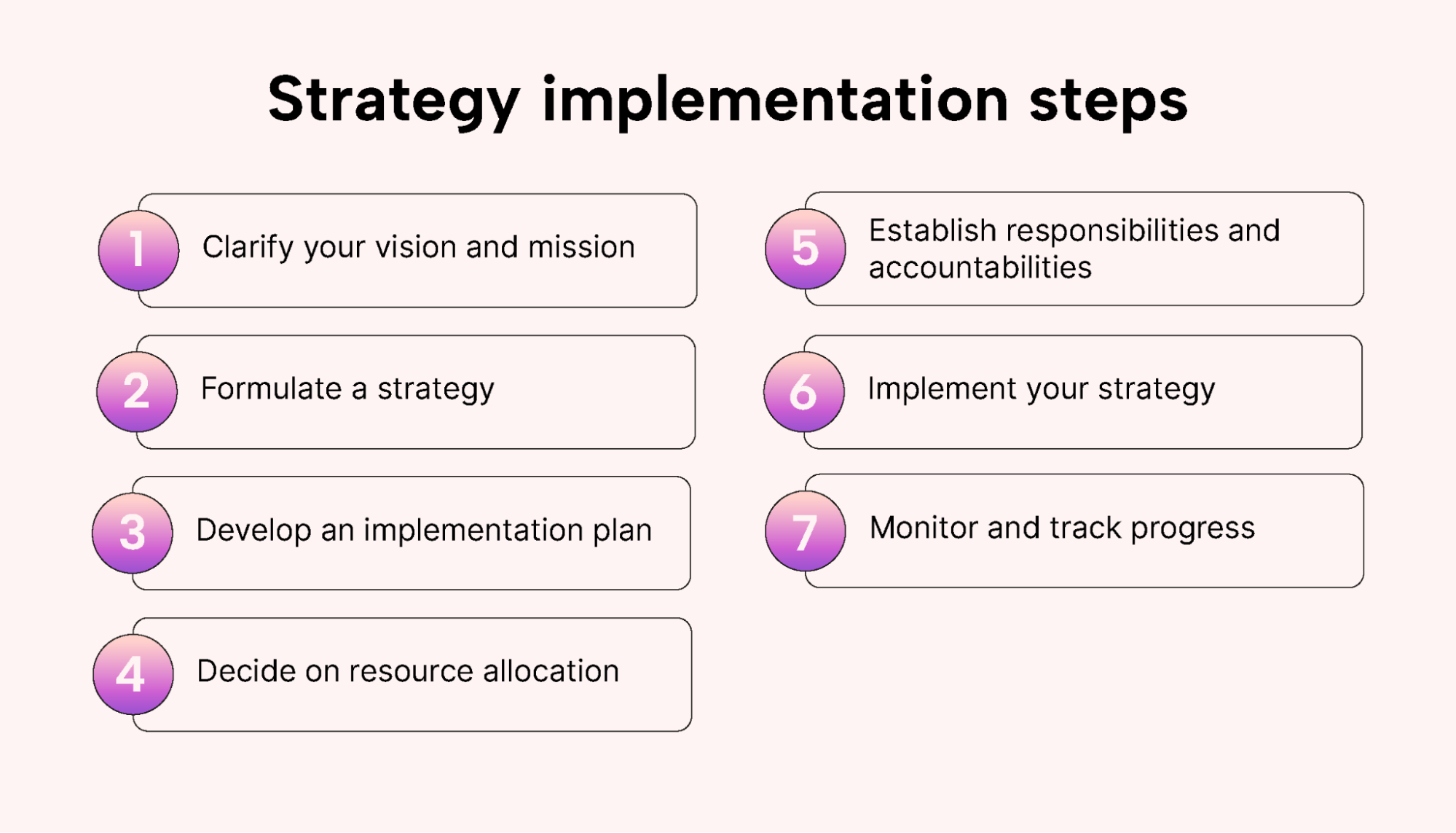Do you find that the path from visionary strategy to tangible results feels like an intricate puzzle? Are you looking for ways to translate high-level objectives into actionable steps?
Enter strategy implementation — the compass that guides businesses from ideation to realization.
In this guide, we decode the nuances of strategy implementation, offering insights and practical steps to help businesses seamlessly navigate from planning to performance. Dive in to bridge the gap between aspiration and achievement and equip your organization with the tools to thrive in today's competitive landscape.
What is strategic implementation, and why is it important?
Strategy implementation involves the processes, actions, decisions, and activities to execute a strategic plan. The aim is to achieve an organization's strategic objectives and goals by translating a strategy's vision into practical, actionable steps.
Strategy implementation is the action part of the strategic management process, where the chosen strategies are implemented to achieve the organization's goals and objectives. Without proper implementation, even the best-laid strategies can fail. Here are some reasons why a proper implementation strategy is so important:
- Realizing goals: Transforms strategic plans into actions to achieve desired outcomes
- Coordinated effort: Ensures alignment and cooperation across the organization, keeping everyone focused on common objectives
- Resource allocation: Helps in effective and efficient utilization of organizational resources
- Monitoring and control: Enables you to track progress, identify issues, and make necessary adjustments
- Adaptability: Allows organizations to respond to changes in the environment swiftly
- Competitive advantage: Provides an edge over competitors through effective execution of strategies
- Long-term survival and growth: Sets the pathway for continuous improvement, leading to sustainable development and success
Strategy implementation vs. strategy formation
Strategy formation (or formulation) and strategy implementation are two core phases of the strategic management process. While they are interrelated, they serve different purposes and involve distinct activities. Here's a comparison between the two:
 |
Strategy implementation
Strategy implementation focuses on executing the strategic plan. It's about making the strategy work in practice.
The key activities are:
- Resource allocation (time, money, workforce)
- Establishing organizational structures and designs that align with the strategy
- Setting up roles and responsibilities
- Developing detailed operational plans
- Monitoring and controlling the execution of the strategy
- Change management and dealing with resistance
- Communication across the organization
- Adjusting to feedback and making necessary corrections
Strategy formation
Strategy formation involves deciding on the strategic direction of the organization. This phase is about choosing where to compete and how to create a sustainable competitive advantage.
The key activities include:
- Environmental scanning (reviewing external factors, market trends, and competitor analysis)
- Internal analysis (examining strengths, weaknesses, resources, and capabilities)
- Defining the mission, vision, and values
- Setting strategic objectives and goals
- Crafting strategies at different levels (corporate, business, and functional)
- Risk assessment
- Strategy formulation answers the questions "What?" and "Why?"
While strategy formulation is about "deciding on the right things to do," strategy implementation is about "doing those things right." Both phases are critical. A brilliant strategy that's poorly implemented will fail, just as a weak strategy, even if executed perfectly, won't lead to success.
7 strategy implementation steps (with examples)
To give you a better idea of how strategy implementation works, let's consider a hypothetical business scenario of a mid-sized technology company. The organization wants to expand its market share and improve its product line over the next five years.
 |
1. Clarify your vision and mission
First, be clear about your long-term vision (where the organization wants to be in the future) and mission (the organization’s fundamental purpose). The vision is your long-term goal, and the mission is the day-to-day focus.
Having a clear vision and mission gives everyone a common goal and a shared understanding of what the organization aims to achieve in the long run and what it stands for daily. Without this clarity, it’s easy to get lost or off track.
Example:
The company sets a vision to be a leader in innovative tech solutions in its region, with a mission to provide cutting-edge technology products that simplify life and foster connectivity.
2. Formulate a strategy
Next, create a plan (strategy) to reach your vision. This step involves analyzing the internal and external environments and identifying strengths, weaknesses, opportunities, and threats. Based on this analysis, create a strategy that aligns with the organization's vision and mission. Your plan should help you stand out from competitors.
Example:
The company invests in Research and Development (R&D) to innovate its product line and forge partnerships with local distributors to expand its market reach. They plan to differentiate themselves through superior customer service and community engagement.
3. Develop an implementation plan
Once you have formulated a strategy, the focus shifts to developing a detailed implementation plan. Break the strategy into actionable tasks, set timelines, and identify necessary resources. This crucial roadmap guides the organization in executing the strategy, ensuring everyone is aligned on the steps they must take.
Example:
The team breaks down their strategy into actionable tasks like:
- Hiring additional R&D staff
- Initiating partnership talks with distributors
- Setting up a customer service training program for their employees.
They set deadlines for each task for the next two years.
4. Resource allocation
Allocate the necessary resources such as finances, human resources, and technology to different parts of the organization to support the strategy implementation. After assessing what resources are needed, use a structured approach to distributing resources where they are most needed. This step ensures that different departments or teams have what they need to execute their part of the strategy.
Example:
The company allocates a significant portion of its budget to R&D, marketing, and customer service training. They also decide to hire additional staff and invest in advanced R&D equipment.
5. Establish responsibilities and accountabilities
Define who is responsible for what so that people are accountable for the results. Assign roles, tasks, and responsibilities clearly so everyone knows their role in the strategy implementation plan. This step creates a system of checks and balances, ensuring things are done correctly and on time.
Example:
The company’s management team discusses and decides who will handle what tasks. They assign the following responsibilities:
- The head of R&D is responsible for innovating the product line
- The marketing manager has the task of forging partnerships and promoting the brand
- The customer service manager has the job of improving customer satisfaction rates
6. Implement your strategy
The implementation phase is about turning plans into action. This step is where each person executes the actions they are responsible for as outlined in the implementation plan. This step is crucial because all your previous planning will be in vain without it. It's where your organization starts to see the results of the hard work in planning and preparing.
Example:
The different departments begin executing their respective parts of the plan. The R&D department starts developing new products. The marketing department engages with potential partners and launches an advertising campaign, and the customer service department initiates a training program.
7. Monitor and track progress
The final step, monitoring and tracking progress, is a continuous activity that ensures the strategy remains on course. Use key performance indicators (KPIs) and other defined metrics to measure progress and schedule regular review meetings. Through diligent monitoring, organizations can learn from their experiences, making necessary tweaks to the strategy or its implementation to ensure ongoing success.
 |
Example:
The technology company sets up monthly review meetings to check the progress against the KPIs, such as the number of new products developed, the number of partnerships established, and customer satisfaction rates. They realize their customer satisfaction has improved, but the number of new products is below target. Based on this analysis, they decide to allocate additional resources to R&D to accelerate the product development process.
Key components for successful strategic implementation
Successful strategy implementation relies on several key components.
Maintain clear communication
Effective communication is crucial to ensure that everyone understands the strategy and their role in its implementation. Leaders need to clearly and consistently communicate expectations, goals, and implementation progress. This will help align the organization.
Engage stakeholders
Stakeholder engagement involves interacting with and getting buy-in from individuals or groups with a vested interest in the strategy. This includes employees, investors, suppliers, and customers. Their support and feedback can provide valuable insights and foster a conducive environment for strategy implementation.
Stay agile
An agile approach encourages adaptability and responsiveness to changes in the business environment. An organization can adjust its strategy and implementation plan as necessary by staying agile. The team can then address emerging challenges or opportunities, ensuring the relevance and effectiveness of the strategy.
Celebrate quick wins
Celebrating successes, no matter how small, helps build momentum and motivates the team. Acknowledging and rewarding the achievements as they contribute toward the overall goal is essential. This helps create a positive organizational culture and maintains enthusiasm and engagement among the team.
Provide training and development
Ongoing training and development are essential for equipping employees with the necessary skills and knowledge for strategy implementation. Well-designed training programs ensure that the team is competent and confident in executing their tasks, which, in turn, contributes to the successful implementation of the strategy.
 |
Common challenges in strategy implementation
Implementing a strategy successfully in any organization can be tough. Here are some of the most common issues you might run into, as well as tips on how to overcome these challenges.
Lack of clear understanding
If everyone involved does not clearly understand the strategy, misalignment can occur.
Tip: Communicate the strategy at multiple levels and in different formats. This ensures that every member of the organization understands its significance, objectives, and their role in it.
Inadequate resources
Lack of necessary resources such as time, staffing, finances, or technology can severely hamper the strategic implementation process. Without appropriate resources, strategy implementation can stall.
Tip: Conduct a thorough resource assessment before beginning implementation and allocate resources based on priority.
Resistance to change
Employees might resist new strategic initiatives because of fear of the unknown, loss of job security, or concern over changes in responsibilities.
Tip: Engage with employees early and involve them in the planning phase. Provide adequate training and address concerns openly and honestly.
Ambiguous accountability
If roles and responsibilities aren't clearly defined, there can be overlaps or gaps in task completion.
 |
Tip: Clearly delineate responsibilities and ensure that each team and individual knows their role in the strategy's execution.
External factors
Market shifts, regulatory changes, or unforeseen external events can impact strategy implementation.
Tip:
Regularly review the external environment. Have contingency plans in place and be ready to pivot if necessary.
Implement your strategy successfully with Motion
Strategizing and implementation are crucial for the success of any organization. Motion provides an intuitive platform to streamline this process, ensuring that your strategic initiatives are executed efficiently and effectively.
Whether you're formulating a new strategy or in the phase of implementing one, Motion’s robust features are designed to facilitate seamless communication, task management, and progress tracking among your teams. Engage stakeholders, maintain clear communication, and celebrate quick wins with the insightful analytics provided by Motion.
The path to successful strategy implementation begins with a single step. Make that step count with Motion.
Your successful strategy implementation is just a click away. Sign up for a free 7-day trial and propel your strategy into action.





